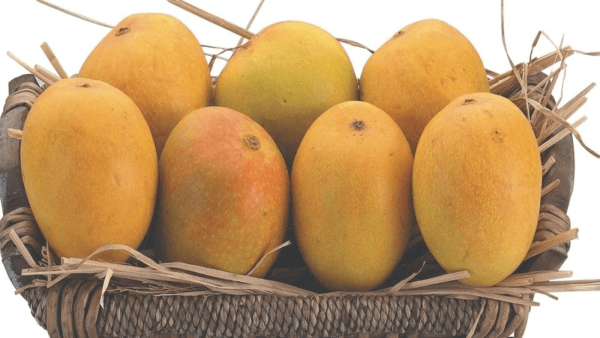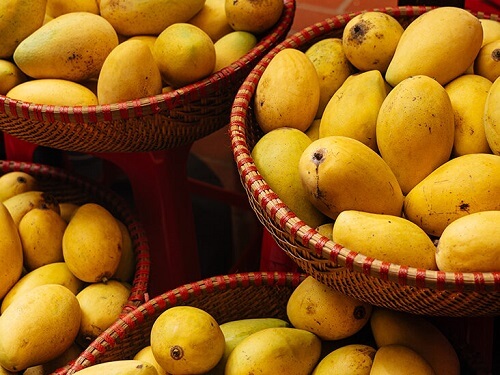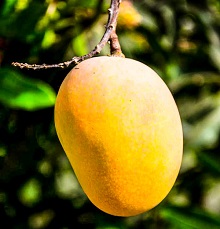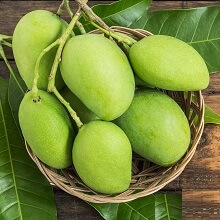Essay on MangoThe mind stands on the twelfth cloud after hearing its name. The tongue starts watering after hearing its name. Eyes get a special shine while getting the sight of it. Here, we are talking about a fruit; it is mango. It is one of the fruits which is loved by almost everyone and is awaited throughout the year. It is declared the National fruit of India. It is not only the national fruit of India but also in Pakistan and the Philippines. Despite this, the Mangifera Indica, i.e. the mango tree, is the National tree of Bangladesh. 
The mango has a special connection with the Mauryan empire's history in Southeast Asia. Not only this, the Indo-Persian poet Amir Khusrow had labelled the mango as the best fruit of Hindustan. He said it as "Naghza Tarin Mewa Hindustan". Mango had also served the courts of the Delhi Sultanate and the Mughal Empire. Not only in ancient or medieval history, but even today, mangoes are consumed and served to gods in Hinduism. Additionally, it is connected to the Jain and Buddhist cultures. Traditionally, the Jain goddess Ambika is represented as she is seated under a mango tree. Likewise, it is also said that Buddha had meditated and rested along with other monks in the Mango grooves. That's why Jains and Buddhists consider the mango tree sacred and holy. The mango leaves are widely used to decorate the house during festivals or ceremonies, considering them holy. It is not only eaten or worshipped but its style or artwork is also used to create wear patterns for clothing. Various Indian textiles, such as the Kashmiri shawls, Silk sarees, and Kanchipuram sarees, bear Mango motifs. Also, it can be found in some of the embroidery styles. Mango is a little bit of solid fruit, holding a large seed in the centre. Such fruits are also known as drupe fruit. This solid edible fruit is mostly produced in tropical regions. To make it simpler to understand, the cashews and pistachios, along with olives, cherries and dates, are also drupes. As they also bear a seed with fleshy fruit and thin skin. The mango tree is generally known as Mangifera Indica, scientifically. Fruits produced by species of the Mangifera genus are also known as mangoes. The word mango took birth in around 1500 and originated through the Malayalam word 'Maanga'. Growing Season and Conditions for MangoGenerally, a Mango tree grows up to 30-40 metres tall. Its leafy area spreads over a radius of around 10-15 metres. The mango trees usually have a long shelf life; some even bloom after the age of 300. For many centuries, growing mango has been an important feature of Indian agriculture. It has been over 4000 years since the native Indian and Southeast Asian people cultivated and enjoyed this juicy fruit. The sapling is planted in an area where the soil is deep as the roots seep in deep and spread widely. The tree leaves are evergreen in nature and change their colour from orange-pink to glossy red into dark green as it transforms from young to mature. Before bearing fruit, the tree blossoms with a small white flower, with a pleasant smell. After flowering, it takes about five months to bear fruit. Although many of the species of fruit bear fruit in summer, some also bear fruit twice a year. Mangoes are of various types, with their own typical tastes, shape, size, colour, way of cultivation and way of eating too. The difference in sizes, sweetness, skin colour, flesh cover and shape of the mango varies according to the cultivator. Indian cuisine has this fruit as a delight in itself. Harvesting of the Mango takes place in the month of March to May in India, while the sale of mango remains at its peak throughout the year. Earlier, they were found only at the end of the dry season. However, nowadays, it is seen in every season, with a range of tastes and shapes. Mango can be of various weights, from a couple of ounces to more than 5 pounds each. Health Benefits of Mango
All fruits are a rich source of Vitamins, Minerals, and Antioxidants, and mango is nowhere lesser than them. Along with its yummy sweet taste, it has many health benefits as it is a rich source of Vitamin C (which is crucial in making blood vessels and Healthy collagen and helps heal) and Vitamin K (which prevents blood clots and strengthens bones). The impressive nutritional profile, along with its delicious mouthwatering taste, makes it good for health-conscious guys and others. The other health benefits are as follows:
Nutrient Content of 1 Mango Serving
One serving of mango provides approximately 70 calories, along with 1g of total fats with negligible or no saturated and Trans fat and more than 1g of protein. It has 0mg of Cholesterol, Sodium, and Potassium. It provides us with 17g of total carbohydrate, 1g of dietary Fiber, and 2g of Natural sugars. It has various nutrients in it. With 15% Vitamin C, and 40% Vitamin A, it is the most cherished fruit for the hot summers in India. Different Ways to Eat MangoesIt not only comes in a variety of sizes but also in the varied breed. They are found throughout the year, but most in the summers. It is much tasty with a hint of tart. However, it is said that the skin of mangoes should not be eaten, as we eat many other fruits. They seem to be bright yellowish and orange when ready to be eaten. But, some breeds are better for eating raw. Often, raw mango is eaten with rock salt. Generally, raw mangoes are used to bring sourness to the dal. Also, they are dried to make pickles or sour powder for use in cooking throughout the year. They also form a great combo with fishes. They are also used to make smoothies, juices, ice cream, chutneys, etc. Ripe mango can be good in smoothies. Moreover, they are cubed to add to cocktails, sliced and added to salsas, cubed and added to quinoa salads, juices, ice cream, added to summer salads, added as a flavouring to Greek yoghurt, prepared to taste in oatmeal, eaten in jams, slices and many other traditional sweets. Different Types of MangoesAs we know, mango varies in flavour and texture. Let us now see some different varieties of mangoes:
Facts about Mango
ConclusionMango is not just a fruit; it is the king of fruits. It has wide varieties and is mostly grown during the summer. Due to its sweet taste, it is also widely consumed in the form of juice.
Next TopicJanmashtmi Essay
|
 For Videos Join Our Youtube Channel: Join Now
For Videos Join Our Youtube Channel: Join Now
Feedback
- Send your Feedback to [email protected]
Help Others, Please Share









